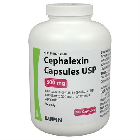Latest Blog Posts:
Get Updates & Coupons
Drug: Cephalexin
Cephalexin is a broad spectrum antibiotic belonging to the cephalosporin group and it is most commonly used for treating many different kinds of bacterial infections. Including use, side effects, and dosing recommendations of Cephalexin. This elaborate guide enables patients to sort out their treatment options.
What is Cephalexin?
Cephalexin is an antibiotic classified as first-generation cephalosporins that disrupts bacterial cell wall formation leading to bactericidal activity. Bacterial skin infections, respiratory tract infections such pneumonia and bronchitis, bone and urinary tract infections are some of the common uses of this drug.
How to Use Cephalexin
To make cephalexin really work, you should strictly stick to the instructions provided by your healthcare provider . This medicine comes in liquid form , tablets or capsules which makes it easier for people with various preferences or age groups. Dosage of treatment depends on how severe the infection is as well as its type, age and renal function of the patient.
Dosage Guidelines
The usual adult dose range for treating bacterial infections can be from 250 mg every 6-12 hours up to 1000 mg per dose. In children, this amounts to 25-50 mg/kg/day divided into several equal doses throughout the day.
Potential Side Effects of Cephalexin
Although cephalexin generally has a good safety profile there might be unwanted effects on users such as;
- Bowel problems such as diarrhea, sickness
- Inflammations that concern skin like rashes or pruritus
- The sensation of dizziness and tiredness experienced by others
However, severe side effects like allergic reactions, serious skin reactions and Clostridium difficile associated diarrhea are possible but rare. Let your healthcare provider know about any severe or persistent adverse reactions that you may notice.
Precautions and Warnings
You should tell your doctor if you have any allergies, particularly to penicillin or other cephalosporins as cross-reactivity may occur before commencing Cephalexin. Also, share details of your medical history especially kidney diseases or gastrointestinal disorders such as colitis.
Interactions with Other Medications
The medications used together with cephalexin might cause some interactions that change how the drugs work in the body or pose a risk for serious side effects. Consequently ensure that all products be they prescriptions over-the-counter drugs, dietary supplements among others are made known to your doctor for professional advice.
Conclusion
Cephalexin is a potent antibiotic used against several bacterial infections. You can safely use Cephalexin by following the prescribed dosage, being aware of potential side effects and discussing any concerns with your healthcare provider . It is important to remember however that antibiotics should only be taken under the instructions of a physician for prevention of resistance development and perfect health outcome attainment during therapy.
FAQs about Cephalexin
- Can I drink alcohol while taking Cephalexin?
- Avoid drinking alcohol when you are on medication because it might raise chances of feeling dizzy and nauseous.
- How long does it take for Cephalexin to work?
- Some patients will experience improvement within a few days of starting their treatment course; however one must finish his/her full course of treatment so he/she can be sure that the infection is entirely gone.
- Is Cephalexin safe during pregnancy?
- Check with your doctor about what’s best for you. Although cephalexin is generally considered safe to use during pregnancy, it should only be taken when necessary.




